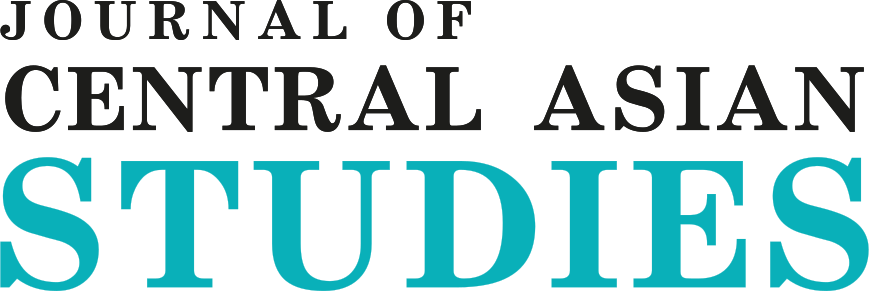Сотрудничество Китая и Центральной Азии: старое вино в новой бутылке или новый коктейль?
DOI:
https://doi.org/10.52536/3006-807X.2024-2.03Ключевые слова:
Сотрудничество Китая и Центральной Азии, С+С5, Инициатива "Пояс и путь", Шелковый путь, Новая большая игра, ИнститутАннотация
В последние годы Центральная Азия привлекла значительное внимание международного сообщества, отчасти благодаря Инициативе «Один пояс, один путь» и продолжающему продвижению Китая в Евразии, а также возобновленному интересу со стороны США, Японии, Индии и Европейского Союза к региону. Последнее привело к институциональной гонке в регионе, которая напоминает «Большую игру» — термин, популяризованный Питером Хопкирком для описания соревнования между Россией и Великобританией в Центральной Азии в XIX веке. Возникающая «Новая Большая Игра» сосредоточена на диалогах по Центральной Азии, которые ряд стран установили для того, чтобы проникнуть в регион и наладить сотрудничество с пятью странами «стан».
Используя свои геополитические и экономические преимущества, Китай установил серию каналов связи с странами Центральной Азии, включая недавние создания механизма сотрудничества Китай-Центральная Азия или C+C5 в 2020 году и Саммит C+C5 в 2023 году. В совокупности с Инициативой «Один пояс, один путь» и Шанхайской организацией сотрудничества Китай демонстрирует явный интерес к расширению своего влияния на запад и формированию благоприятного регионального сообщества в Центральной Азии. Сосредоточившись на сотрудничестве Китай-Центральная Азия, данная статья рассматривает последние усилия Китая в Центральной Азии и другие аналогичные инициативы в регионе, которые совместно служат движущей силой для Новой Большой Игры. Статья предполагает, что C+C5 — это не просто ответвление существующих инициатив, а новая инициатива, обладающая большим потенциалом для дальнейшего сотрудничества между Китаем и Центральной Азией.
Библиографические ссылки
Abajyan, A. (2021). Shanghai Cooperation Organization as a Platform for Promoting the Agenda of China's Belt and Road Initiative. Banber Arevelagitut'yan Instituti, 1(2), 144-154.
Aidarkhanova, E. (2023, November 23). Why Is the Eurasian Economic Union Broken? Retrieved from The Diplomat: https://thediplomat.com/2023/11/why-is-the-eurasian-economic-union-broken/
Akhtar, M., & Javaid, F. (2021). Is the Shanghai Cooperation Organization Making a “NATO of the East”? Pakistan Journal of International Affairs, 4(3), 599-615.
Avdaliani, E. (2024, February 20). China Uses Crises to Build Central Asia Influence. Retrieved from Europe’s Edge: https://cepa.org/article/china-uses-crises-to-build-central-asia-influence/
Azizi, S. (2024). China’s Belt and Road Initiative (BRI): The Role of the Shanghai Cooperation Organization (SCO) in Geopolitical Security and Economic Cooperation. Open Journal of Political Science, 14, 111-129.
Chao, W. (2022). The Political Economy of China’s Rising Role in the Shanghai Cooperation Organization (SCO): Leading with Balance. The Chinese Economy, 55(4), 293-302.
China, Central Asian Countries Vow to Build Community with Shared Future. (2022). Retrieved from The State Council, PRC: https://english.www.gov.cn/news/topnews/ 202201/27/content_WS61f1f7c6c6d09c94e48a457c.html
China’s Position on the Political Settlement of the Ukraine Crisis. (2023). Retrieved from Ministry of Foreign Affairs, PRC. : https://www.fmprc.gov.cn/mfa_eng/zxxx_662805/202302/t20230224_11030713.html
Evaluation of ADB Support for the Central Asia Regional Economic Cooperation Program, 2011-2021. (2024). Retrieved from Asian Development Bank: https://www.adb.org/sites/default/files/Evaluation%20Document/790821/files/ce-carec.pdf
Hu, B. (2019). Belt and Road Initiative: Five Years on Implementation and Reflection. Global Journal of Emerging Market Economies, 11(1-2), 1-10.
Kaushiki, N. (2013). The New Great Game and India’s Connect Central Asia Policy: Strategic Perspectives and Challenges. Journal of International and Area Studies, 20(2), 83-100.
Khan, J., & Sultana, R. (2021). Sino-Russia Strategic Partnership: The Case Study of Shanghai Cooperation Organization (SCO). FWU Journal of Social Sciences, 15(2), 1-19.
Lei, J. (2023). The Construction of ‘China-Central Asia-West Asia Economic Corridor’ in the Post-COVID Era: Challenges, Prospects and Responses. Journal of Education, Humanities and Social Sciences, 8, 1526-1533.
Li, S. (2023, September 11). China-Central Asia Cooperation Forum Explores Win-Win Opportunities. Retrieved from Xinhua News: https://eng.yidaiyilu.gov.cn/p/0EA3FHN1.html
Murashkin, N. (2020). Japan and the New Silk Road: Diplomacy, Development and Connectivity. London: Routledge.
Nemoto, R. (2023, September 22). Japan Seeks to Boost Central Asia Relations with 1st Summit in 2024. Retrieved from Nikkei Asia: https://asia.nikkei.com/Politics/International-relations/Japan-seeks-to-boost-Central-Asia-relations-with-1st-summit-in-2024
Nurimbetov, R., & Vasa, L. (2021). The Shanghai Cooperation Organization in a Changing Central Asian Geopolitical Context. Academic and Applied Research in Military and Public Management Science (AARMS), 20(2), 27-38.
Popovic, S., & Stevic, L. (2021). The Position of the New Security Concept in China’s Foreign Policy – Case Study on the Shanghai Cooperation Organization. Contemporary Chinese Political Economy and Strategic Relations: An International Journal, 7(2), 717-750.
Pradhan, R. (2018). The Rise of China in Central Asia: the New Silk Road Diplomacy. Fudan Journal of The Humanities and Social Sciences, 11, 9-29.
President Xi Jinping Chairs the Inaugural China-Central Asia Summit and Delivers a Keynote Speech. (2023). Retrieved from Ministry of Foreign Affairs, PRC: https://www.mfa.gov.cn/eng/zxxx_662805/202305/t20230519_11080116.html
Rauf, S., & Saud, A. (2020). Prospects of CSTO and SCO in Regional Politics of Central Asia. International Journal of Politics and Security, 2(4), 30-50.
Rogers, R. (2007). The Shanghai Cooperation Organization, China and the New Great Game in Central Asia. Journal of International Studies, 3, 92-105.
Sachdeva, G. (2022, April 14). India’s Central Asia Challenge. Retrieved from East Asia Forum: https://eastasiaforum.org/2022/04/14/indias-central-asia-challenge/
The New Great Game in Asia. (1996, January 2). Retrieved from The New York Times: https://www.nytimes.com/1996/01/02/opinion/the-new-great-game-in-asia.html
Tsai, T., Hung, M., & Liu, T. (2011). China’s Foreign Policy in Southeast Asia: Harmonious Worldview and Its Impact on Good Neighbor Policy. Journal of Contemporary Eastern Asia, 10(1), 25-42.
Uzakbaev, N., & Movkebaeva, G. (2022). Central Asian States in the Shanghai Cooperation Organization: The Role and Place of the SCO on the Distribution of the Power Balance in the Region. Bulletin Series: International Relations and Regional Studies, 50(4), 34-44.
Yazdani, E. (2020). The Shanghai Cooperation Organization: An Emerging Venue for China’s New Diplomacy. China Quarterly of International Strategic Studies, 6(4), 451-475.
Загрузки
Опубликован
Выпуск
Раздел
Лицензия
Copyright (c) 2024 Тони Т.Т.

Это произведение доступно по лицензии Creative Commons «Attribution» («Атрибуция») 4.0 Всемирная.










 Open content is licensed under the CC-BY
Open content is licensed under the CC-BY 


